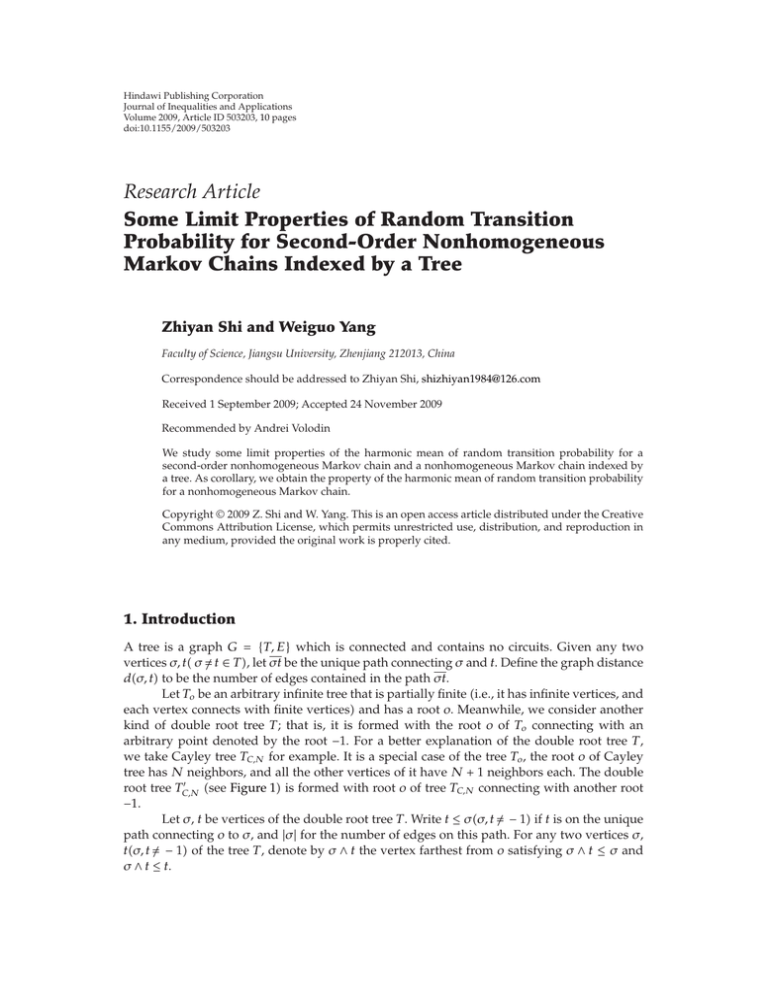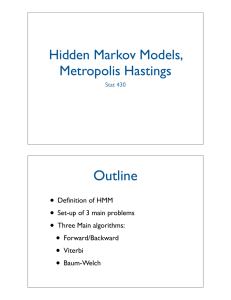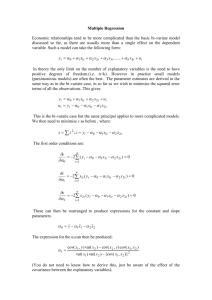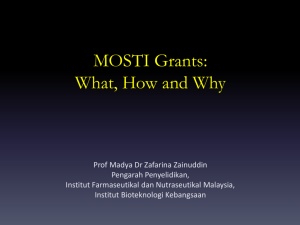Document 10940131
advertisement

Hindawi Publishing Corporation
Journal of Inequalities and Applications
Volume 2009, Article ID 503203, 10 pages
doi:10.1155/2009/503203
Research Article
Some Limit Properties of Random Transition
Probability for Second-Order Nonhomogeneous
Markov Chains Indexed by a Tree
Zhiyan Shi and Weiguo Yang
Faculty of Science, Jiangsu University, Zhenjiang 212013, China
Correspondence should be addressed to Zhiyan Shi, shizhiyan1984@126.com
Received 1 September 2009; Accepted 24 November 2009
Recommended by Andrei Volodin
We study some limit properties of the harmonic mean of random transition probability for a
second-order nonhomogeneous Markov chain and a nonhomogeneous Markov chain indexed by
a tree. As corollary, we obtain the property of the harmonic mean of random transition probability
for a nonhomogeneous Markov chain.
Copyright q 2009 Z. Shi and W. Yang. This is an open access article distributed under the Creative
Commons Attribution License, which permits unrestricted use, distribution, and reproduction in
any medium, provided the original work is properly cited.
1. Introduction
A tree is a graph G {T, E} which is connected and contains no circuits. Given any two
vertices σ, t σ / t ∈ T , let σt be the unique path connecting σ and t. Define the graph distance
dσ, t to be the number of edges contained in the path σt.
Let To be an arbitrary infinite tree that is partially finite i.e., it has infinite vertices, and
each vertex connects with finite vertices and has a root o. Meanwhile, we consider another
kind of double root tree T ; that is, it is formed with the root o of To connecting with an
arbitrary point denoted by the root −1. For a better explanation of the double root tree T ,
we take Cayley tree TC,N for example. It is a special case of the tree To , the root o of Cayley
tree has N neighbors, and all the other vertices of it have N 1 neighbors each. The double
see Figure 1 is formed with root o of tree TC,N connecting with another root
root tree TC,N
−1.
Let σ, t be vertices of the double root tree T . Write t ≤ σσ, t /
− 1 if t is on the unique
path connecting o to σ, and |σ| for the number of edges on this path. For any two vertices σ,
tσ, t /
− 1 of the tree T , denote by σ ∧ t the vertex farthest from o satisfying σ ∧ t ≤ σ and
σ ∧ t ≤ t.
2
Journal of Inequalities and Applications
t
Level 3
Level 2
1t
Level 1
2t
Level 0
Root o
Level −1
Root −1
Figure 1: Double root tree TC,2
.
The set of all vertices with distance n from root o is called the nth generation of T ,
which is denoted by Ln . We say that Ln is the set of all vertices on level n and especially root
−1 is on the −1st level on tree T . We denote by T n the subtree of the tree T containing the
n
vertices from level −1 the root −1 to level n and denote by To the subtree of the tree To
containing the vertices from level 0 the root o to level n. Let t / o, −1 be a vertex of the tree
T . We denote the first predecessor of t by 1t , the second predecessor of t by 2t , and denote by
nt the nth predecessor of t. Let X A {Xt , t ∈ A}, and let xA be a realization of X A and denote
by |A| the number of vertices of A.
Definition 1.1. Let G {1, 2, . . . , N} and P z | y, x be nonnegative functions on G3 . Let
P P z | y, x ,
P z | y, x ≥ 0, x, y, z ∈ G.
1.1
If
P z | y, x 1,
1.2
z∈G
then P is called a second-order transition matrix.
Definition 1.2. Let T be double root tree and let G {1, 2, . . . , N} be a finite state space, and
let {Xt , t ∈ T } be a collection of G-valued random variables defined on the probability space
Ω, F, P . Let
P p x, y ,
x, y ∈ G
1.3
be a distribution on G2 , and
Pt Pt z | y, x ,
x, y, z ∈ G, t ∈ T \ {o}{−1}
1.4
Journal of Inequalities and Applications
3
be a collection of second-order transition matrices. For any vertex t t /
o, −1, if
P Xt z | X1t y, X2t x, Xσ for σ ∧ t ≤ 1t
P Xt z | X1t y, X2t x Pt z | y, x
P X−1 x, Xo y p x, y , x, y ∈ G,
∀x, y, z ∈ G,
1.5
then {Xt , t ∈ T } is called a G-value second-order nonhomogeneous Markov chain indexed by
a tree T with the initial distribution 1.3 and second-order transition matrices 1.4, or called
a T -indexed second-order nonhomogeneous Markov chain.
Remark 1.3. Benjamini and Peres 1 have given the definition of the tree-indexed
homogeneous Markov chains. Here we improve their definition and give the definition of the
tree-indexed second-order nonhomogeneous Markov chains in a similar way. We also give
the following definition Definition 2.3 of tree-indexed nonhomogeneous Markov chains.
There have been some works on limit theorems for tree-indexed stochastic processes.
Benjamini and Peres 1 have given the notion of the tree-indexed Markov chains and studied
the recurrence and ray-recurrence for them. Berger and Ye 2 have studied the existence
of entropy rate for some stationary random fields on a homogeneous tree. Ye and Berger
see 3, 4, by using Pemantle’s result 5 and a combinatorial approach, have studied
the Shannon-McMillan theorem with convergence in probability for a PPG-invariant and
ergodic random field on a homogeneous tree. Yang and Liu 6 have studied a strong law
of large numbers for the frequency of occurrence of states for Markov chains field on a
homogeneous tree a particular case of tree-indexed Markov chains field and PPG-invariant
random fields. Yang see 7 has studied the strong law of large numbers for frequency
of occurrence of state and Shannon-McMillan theorem for homogeneous Markov chains
indexed by a homogeneous tree. Recently, Yang see 8 has studied the strong law of large
numbers and Shannon-McMillan theorem for nonhomogeneous Markov chains indexed by
a homogeneous tree. Huang and Yang see 9 have also studied the strong law of large
numbers for Markov chains indexed by an infinite tree with uniformly bounded degree.
Let Pt xt | x1t , x2t Pt Xt xt | X1t x1t , X2t x2t . Then Pt Xt | X1t , X2t is called
the random transition probability of a T -indexed second-order nonhomogeneous Markov
chain. Liu 10 has studied a strong limit theorem for the harmonic mean of the random
transition probability of finite nonhomogeneous Markov chains. In this paper, we study some
limit properties of the harmonic mean of random transition probability for a second-order
nonhomogeneous Markov chain and a nonhomogeneous Markov chain indexed by a tree.
As corollary, we obtain the results of 10, 11.
2. Main Results
Lemma 2.1. Let {Xt , t ∈ T } be a T -indexed second-order nonhomogeneous Markov chain with state
space G defined as in Definition 1.2, and let {gt x, y, z, t ∈ T } be a collection of functions defined on
n
G3 . Let L−1 {−1}, L0 {o}, and Fn σX T . Set
tn λ, ω eλ
t∈T n \{o}{−1}
gt X2t ,X1t ,Xt λg X ,X ,X ,
t
2t
1t
t
| X1t , X2t
t∈T n \{o}{−1} E e
where λ is a real number. Then {tn λ, ω, Fn , n ≥ 1} is a nonnegative martingale.
2.1
4
Journal of Inequalities and Applications
Proof. Obviously, when n ≥ 1, we have
n
n n
P X T xT
P X−1 x−1 , Xo xo P xT
Pt xt | x1t , x2t .
2.2
t∈T n \{o}{−1}
Hence
n P
xT
Ln
Ln
T n−1
T n−1
n−1 P X x |X
x
Pt xt | x1t , x2t .
P xT
t∈Ln
2.3
Then
E eλ t∈Ln gt X2t ,X1t ,Xt | Fn−1
eλ
t∈Ln
gt X2t ,X1t ,xt t∈Ln
gt X2t ,X1t ,xt xLn ∈GLn
eλ
xLn ∈GLn
n−1
P X Ln xLn | X T
Pt xt | X1t , X2t t∈Ln
2.4
eλgt X2t ,X1t ,xt Pt xt | X1t , X2t t∈Ln xt ∈G
a.e.
E eλgt X2t ,X1t ,Xt | X1t , X2t
t∈Ln
On the other hand, we also have
eλ t∈Ln gt X2t ,X1t ,Xt tn λ, ω tn−1 λ, ω .
λg X ,X ,X t
2t
1t
t
| X1t , X2t
t∈Ln E e
2.5
Combining 2.4 and 2.5, we arrive at
Etn λ, ω | Fn−1 tn−1 λ, ω
a.e.,
2.6
Thus the lemma is proved.
Theorem 2.2. Let {Xt , t ∈ T } be a T -indexed second-order nonhomogeneous Markov chain with state
space G defined as in Definition 1.2, and its initial distribution and probability transition collection
satisfying
P X−1 x−1 , Xo xo P x, y > 0, ∀x, y ∈ G,
Pt z | y, x > 0, ∀x, y, z ∈ G, t ∈ T \ {o}{−1},
2.7
Journal of Inequalities and Applications
5
respectively. Let
bt min Pt z | y, x , x, y, z ∈ G ,
t ∈ T \ {o}{−1}.
2.8
If there exists a> 0 such that
1
lim sup n T n→∞
ea/bt M < ∞,
2.9
t∈T n \{o}{−1}
then the harmonic mean of the random conditional probability {Pt Xt | X1t , X2t , t ∈ T n \ {o}{−1}}
converges to 1/N a.e., that is,
n T lim n→∞
t∈T n \{o}{−1}
Pt Xt | X1t , X2t −1
1
N
2.10
a.e .
Proof. Let gt x, y, z Pt z | y, x−1 in Lemma 2.1. Then it follows from Lemma 2.1 that
eλ
tn λ, ω t∈T n \{o}{−1}
t∈T n \{o}{−1} E
Pt Xt |X1t ,X2t −1
2.11
−1
eλPt Xt |X1t ,X2t | X1t , X2t
is a nonnegative martingale. According to Doob martingale convergence theorem, we have
lim tn λ, ω tλ, ω < ∞ a.e .
2.12
n→∞
Thus
1
lim sup n ln tn λ, ω ≤ 0
T n→∞
2.13
a.e.
It follows from 2.11 and 2.13 that
⎧
⎨
1
lim sup n λ
⎩
T
n→∞
Pt Xt | X1t , X2t −1
t∈T n \{o}{−1}
−
t∈T n \{o}{−1}
⎫
⎬
−1
≤0
ln E eλPt Xt |X1t ,X2t | X1t , X2t
⎭
2.14
a.e.
6
Journal of Inequalities and Applications
By 2.14 and the inequalities ln x ≤ x − 1x > 0, and 0 ≤ ex − 1 − x ≤ x2 /2e|x| , we have
1
lim sup n T n→∞
λPt Xt | X1t , X2t −1 − λN
t∈T n \{o}{−1}
1
≤ lim sup n T n→∞
1
≤ lim sup n T n→∞
−1
ln E eλPt Xt |X1t ,X2t | X1t , X2t − λN
t∈T n \{o}{−1}
−1
E eλPt Xt |X1t ,X2t | X1t , X2t − 1 − λN
t∈T n \{o}{−1}
1
lim sup n T
n→∞
−1
Pt xt | X1t , X2t eλPt xt |X1t ,X2t − 1 − λPt xt | X1t , X2t −1
t∈T n \{o}{−1}xt ∈G
≤
−1
λ2
1
lim sup n Pt xt | X1t , X2t −1 e|λ|Pt xt |X1t ,X2t 2 n→∞ T
t∈T n \{o}{−1}xt ∈G
≤
1
1
λ2
lim sup n e|λ|/bt
2 n → ∞ T t∈T n \{o}{−1}xt ∈G bt
≤
1
1 |λ|/bt
λ2 N
lim sup n e
2 n→∞ T
b
t∈T n \{o}{−1} t
a.e.
2.15
It is easy to see that
max{xλx , x > 0} −
0<λ<1
e−1
.
ln λ
2.16
Let 0 < λ < a, by 2.15, 2.16, 2.8, and 2.9 we have
1
lim sup n T
n→∞
≤
Pt Xt | X1t , X2t −1 − N
t∈T n \{o}{−1}
1
1 λ/bt
λN
lim sup n e
2 n → ∞ T t∈T n \{o}{−1} bt
1
1
λN
lim sup n 2 n→∞ T
b
t∈T n \{o}{−1} t
eλ
ea
1/bt
≤
1
λN
lim sup n ea/bt
2a − λe n → ∞ T t∈T n \{o}{−1}
λN
M,
2a − λe
ea/bt
2.17
Journal of Inequalities and Applications
7
Letting λ → 0 , by 2.17, we have
1
lim sup n T
n→∞
Pt Xt | X1t , X2t −1 − N ≤ 0
a.e .
2.18
t∈T n \{o}{−1}
Let −a < λ < 0, by 2.15,2.8, and 2.9 we have
1
lim inf n n → ∞ T
Pt Xt | X1t , X2t −1 − N
t∈T n \{o}{−1}
1
1 −λ/bt
λN
lim sup n e
2 n → ∞ T t∈T n \{o}{−1} bt
≥
1
1
λN
lim sup n 2 n→∞ T
b
t∈T n \{o}{−1} t
e−λ
ea
1/bt
≥
1
λN
lim sup n ea/bt
2a λe n → ∞ T t∈T n \{o}{−1}
λN
M.
2a λe
ea/bt
2.19
Letting λ → 0− , by 2.19, we have
1
lim inf n n → ∞ T
Pt Xt | X1t , X2t −1 − N ≥ 0
a.e .
2.20
t∈T n \{o}{−1}
Combining 2.18 and 2.20, we obtain 2.10 directly.
From the definition above, we know that the difference between To and T lies in
whether the root o is connected with another root −1. In the following, we will investigate
some properties of the harmonic mean of the transition probability of nonhomogeneous
Markov chains on the tree To . First, we give the definition of nonhomogeneous Markov chains
on the tree To .
Definition 2.3. Let To be an arbitrary tree that is partly finite, let G {1, 2, . . . , N} be a finite
state space, and let {Xt , t ∈ To } be a collection of G-valued random variables defined on the
probability space Ω, F, P . Let
P px ,
x∈G
2.21
be a distribution on G, and
Pt Pt y | x ,
x, y ∈ G, t ∈ To \ {o}
2.22
8
Journal of Inequalities and Applications
be a collection of transition matrices. For any vertex t t /
o, if
P Xt y | X1t x, Xσ for σ ∧ t ≤ 1t P Xt y | X1t x Pt y | x ,
P Xo x px,
∀x, y ∈ G,
x ∈ G,
2.23
then {Xt , t ∈ To } is called a G-value nonhomogeneous Markov chain indexed by a tree
To with the initial distribution 2.21 and transition matrices 2.22, or called a To -indexed
nonhomogeneous Markov chain.
Let Pt xt | x1t Pt Xt xt | X1t x1t . Then Pt Xt | X1t is called the random
transition probability of a To -indexed nonhomogeneous Markov chain. Since a Markov chain
is a special case of a second-order Markov chain, we may regard the nonhomogeneous
Markov chain on To to be a special case of the second-order nonhomogeneous Markov chain
on T when we do not take the difference of To and T on the root −1 into consideration. Thus for
the nonhomogeneous Markov chain on the tree To , we can get the results similar to Lemma 2.1
and Theorem 2.2.
Lemma 2.4. Let {Xt , t ∈ To } be a To -indexed second-order nonhomogeneous Markov chain with state
space G defined as in Definition 2.3, and let {gt x, y, t ∈ To } be a collection of functions defined on
n
G2 . Let L0 {o} and Fn σX To . Set
tn λ, ω e
λ
n
t∈To \{o}
gt X1t ,Xt ,
n
E eλgt X1t ,Xt | X1t
t∈To \{o}
2.24
where λ is a real number. Then {tn λ, ω, Fn , n ≥ 1} is a nonnegative martingale.
Theorem 2.5. Let {Xt , t ∈ To } be a To -indexed nonhomogeneous Markov chain with state space G
defined as in Definition 2.3, and its initial distribution and probability transition collection satisfying
P Xo x px > 0, ∀x ∈ G,
Pt y | x > 0, ∀x, y ∈ G, t ∈ To \ {o},
2.25
respectively. Let
bt min Pt y | x , x, y ∈ G ,
t ∈ To \ {o}.
2.26
If there exists a> 0 such that
1
ea/bt M < ∞,
lim sup n n → ∞ To n
t∈To \{o}
2.27
Journal of Inequalities and Applications
9
n
then the harmonic mean of the random conditional probability {Pt Xt | X1t , t ∈ To
converges to 1/N a.e., that is
n To lim n→∞
n
t∈To \{o}
Pt Xt | X1t −1
1
N
a.e.
\ {o}}
2.28
If the successor of each vertex of the tree To has only one vertex, then the
nonhomogeneous Markov chains on the tree To degenerate into the general nonhomogeneous
Markov chains. Thus we obtain the results in 10, 11.
Corollary 2.6 see 10, 11. Let {Xn , n ≥ 0} be a nonhomogeneous Markov chain with state space
G, and its initial distribution and probability transition sequence satisfying
pi > 0,
i ∈ G,
i, j ∈ G, k 1, 2, . . . ,
Pk i, j > 0,
2.29
respectively. Let
ak min Pk i, j , i, j ∈ G ,
k 1, 2, . . . .
2.30
If there exists a> 0 such that
lim sup
n→∞
n
1
ea/ak M < ∞,
n k1
2.31
then
lim n
n→∞
k1
n
Pk Xk | Xk−1 −1
1
N
a.e .
2.32
Proof. When the successor of each vertex of the tree To has only one vertex, the
nonhomogeneous Markov chains on the tree To degenerate into the general nonhomogeneous
Markov chains, the corollary follows directly from Theorem 2.5.
Acknowledgments
This work is supported by the National Natural Science Foundation of China 10571076,
and the Postgraduate Innovation Project of Jiangsu University no. CX09B 13XZ and the
Student’s Research Foundation of Jiangsu University no. 08A175.
References
1 I. Benjamini and Y. Peres, “Markov chains indexed by trees,” The Annals of Probability, vol. 22, no. 1,
pp. 219–243, 1994.
10
Journal of Inequalities and Applications
2 T. Berger and Z. X. Ye, “Entropic aspects of random fields on trees,” IEEE Transactions on Information
Theory, vol. 36, no. 5, pp. 1006–1018, 1990.
3 Z. Ye and T. Berger, “Ergodicity, regularity and asymptotic equipartition property of random fields
on trees,” Journal of Combinatorics, Information & System Sciences, vol. 21, no. 2, pp. 157–184, 1996.
4 Z. Ye and T. Berger, Information Measures for Discrete Random Fields, Science Press, Beijing, China, 1998.
5 R. Pemantle, “Automorphism invariant measures on trees,” The Annals of Probability, vol. 20, no. 3,
pp. 1549–1566, 1992.
6 W. Yang and W. Liu, “Strong law of large numbers for Markov chains field on a Bethe tree,” Statistics
& Probability Letters, vol. 49, no. 3, pp. 245–250, 2000.
7 W. Yang, “Some limit properties for Markov chains indexed by a homogeneous tree,” Statistics &
Probability Letters, vol. 65, no. 3, pp. 241–250, 2003.
8 W. Yang and Z. Ye, “The asymptotic equipartition property for nonhomogeneous Markov chains
indexed by a homogeneous tree,” IEEE Transactions on Information Theory, vol. 53, no. 9, pp. 3275–
3280, 2007.
9 H. Huang and W. Yang, “Strong law of large numbers for Markov chains indexed by an infinite tree
with uniformly bounded degree,” Science in China, vol. 51, no. 2, pp. 195–202, 2008.
10 W. Liu, “A strong limit theorem for the harmonic mean of the random transition probabilities of finite
nonhomogeneous Markov chains,” Acta Mathematica Scientia, vol. 20, no. 1, pp. 81–84, 2000 Chinese.
11 W. Liu, “A limit property of random conditional probabilities and an approach of conditional moment
generating function,” Acta Mathematicae Applicatae Sinica, vol. 23, no. 2, pp. 275–279, 2000 Chinese.






